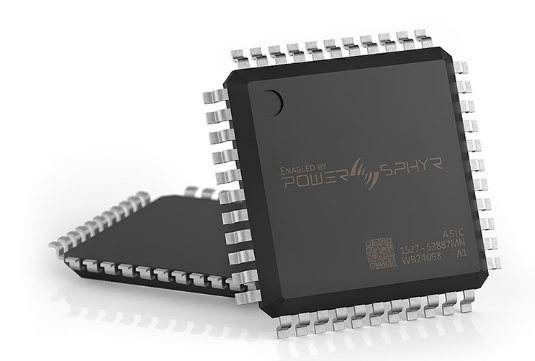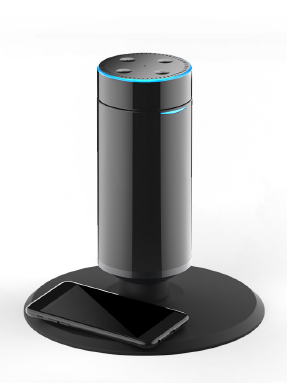By Nicole DiGiose, content editor
You’ll come across plenty of useful gadgets in today’s high-tech world — a smartphone loaded with apps, a wearable that monitors your sleep, even a fork that counts your calories — but every new device you buy comes with its own cable and charging brick. Usually this is fine, until you have a drawer of tangled cords and aren’t sure which cable plugs into which device. Fortunately, thanks to technology and consumer electronics company, PowerSphyr, that’s about to be an issue of the past.
Because there are numerous applications for wireless technology — including consumer, medical, industrial, and automotive — the possibilities are endless. With the promise to rapidly recharge devices or trickle-charge devices over time without a cable, PowerSphyr is developing applications in these industries.
But ditching the wires isn’t the only thing that makes this technology stand out from the crowd. According to David Meng, chief technology & marketing officer of PowerSphyr, the magic lies in the startup’s wireless solution, SkyCurrent, which is based off of multi-modes: a combination of near-field and far-field technology. “We’re the only ones in the world that are delivering this comprehensive multi-mode technology,” Meng told Electronic Products. Combining the two technologies was previously thought to be near-impossible.

Image source: PowerSphyr.
So how does this all come together? Meng said that PowerSphyr will first deliver its consumer products under the SkyCurrent brand that it’s launching this fall. “At the heart, we’re a technology company, and we just partnered with ON Semiconductor, so we’ll be licensing and selling chipsets with our technology embedded in them,” he said. Basically, PowerSphyr is one technology with two parts: retail and chipsets.
Wireless power by SkyCurrent
SkyCurrent is a series of products for PowerSphyr’s multi-mode wireless technology. Designed as a power hub to be the focal point of the room it resides in, it can be placed on your desktop or counter and will support the Amazon Echo Dot. It’s capable of recharging mobile devices, wearables, and any gadget with a built-in receiver to accept wireless power. Simply put, PowerSphyr’s looking to cut the cord to the traditional method of recharging.
A huge part of SkyCurrent, other than the power hub, will be aimed at mobile phones. “For smartphones, we’ll offer a sleeve you can purchase along with the power hub that can act as a universal receiver for wireless power,” said Meng. “That will be backwards-compatible with other wireless standards that are currently available, so we’ll be releasing that for the different major smartphones on the market.”

Image source: PowerSphyr.
Near-field meets far-field
According to Meng, in the wireless power industry, most leaders focus on one technology, or on one technique, and offer it as a solution to their consumers. Because there are different kinds of wireless power, and not one type of power is suitable for all devices, the team behind PowerSphyr saw that as an issue that needed to be addressed.
“Imagine a device like a wearable, such as a Fitbit, for example,” said Meng. “It uses very little energy compared to a plus-size smartphone or a tablet or a laptop. All of those devices consume different levels of energy and it’s generally understood in power electronics that there’s not one type of wireless power that’s suitable for all of them. So that’s why PowerSphyr is being developed. It takes advantage of near-field and blends it with the advantages of far-field.”
Because the industry either focuses on near-field or far-field, but never together in a comprehensive solution, PowerSphyr uses magnetic resonance, the next generation of magnetic induction technology that already exists, for near-field technology. “Magnetic induction, such as the Qi, already has existed in the consumer electronics market for over a decade,” said Meng. “It’s in lots of phones right now, and we tend to refer to Qi as the older technology. Our near-field is based off of magnetic resonance, which we see as the new generation of that technology. It offers a lot of features and functionality that the traditional Qi, or magnetic induction, does not.”
Magnetic resonance is based on magnetics, but it offers more spatial freedom and accommodates more than one device with different power requirements, according to Meng. This is the power of next-gen technology, but that’s just near-field.
As for far-field, PowerSphyr utilizes the technology in the form of radio frequency (RF). Because it’s radiated energy that can transfer power over a greater distance, this allows for even greater spatial freedom — from three to six feet away from the power hub, devices can absorb and receive a low-power trickle-charge.
Because far-field technology is at a greater distance, the solution is not intended to be an actual charge for smartphones, because most of today’s phones require 5 to 12 watts of charged energy. To get around that, PowerSphyr will be selling a wireless power receiver in the form of a smartphone sleeve, which will be equipped with a battery bank to absorb the far-field charge from a distance. This way, you’ll have room to walk around while using your phone while it’s receiving a charge.
The next Industrial Revolution?
As Meng put it, this evolution in wireless technology could be the next Industrial Revolution. The IoT industry anticipates each room in every building across the world to come equipped with a variety of sensors, all communicating with one another.
“All of your devices will be talking to each other, relying on sensors that are spread throughout the building,” said Meng. “This will be a huge data-driven environment, and those devices need to be powered, and they’ll be powered wirelessly.”
To learn more about the benefits of PowerSphyr’s wireless technology and how it’s shaking up the industry, visit powersphyr.com.
Advertisement
Learn more about Electronic Products Magazine





